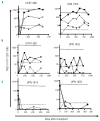T-cell reconstitution after allogeneic stem cell transplantation: assessment by measurement of the sjTREC/βTREC ratio and thymic naive T cells
- PMID: 23585532
- PMCID: PMC3789466
- DOI: 10.3324/haematol.2012.072264
T-cell reconstitution after allogeneic stem cell transplantation: assessment by measurement of the sjTREC/βTREC ratio and thymic naive T cells
Abstract
The immune reconstitution after allogeneic hematopoietic stem cell transplantation comprises thymus-dependent and thymus-independent pathways. We wanted to improve the understanding of this complex process using two different measurements at definite checkpoints of T-cell neogenesis. We therefore assessed the thymus-dependent pathway by combining measurements of single joint T-cell receptor excision circles (sjTREC) and β T-cell receptor excision circles (βTREC) in an improved quantitative light-cycler hybridization polymerase chain reaction assay. In a subgroup of patients, we additionally assessed the proliferation kinetics of the CD31(+) thymic naïve cell population, which corresponds to recent thymic emigrants by six-color immunostaining. After the establishment of normal values in 22 healthy volunteers, we applied our polymerase chain reaction to 66 patients undergoing allogeneic hematopoietic stem cell transplantation at a median age of 44 years. It took more than 2 years after transplant to restore the pre-transplant thymic proliferation capacity. Only one third of the patients in our longitudinal study reached age-adjusted normal values for both sjTREC and βTREC at a median follow-up of 558 days, with acute graft-versus-host disease being the most prominent negative factor by univariate analysis. We observed several patterns of sjTREC and βTREC recovery suggesting different mechanisms of thymic damage in individual patients. In a comparison of CD31(+) thymic naïve cells between volunteers and patients after transplant we found a significantly higher peak proliferation rate within the latter population in the first year after transplantation. The combination of measurements of sjTREC and βTREC by our simplified polymerase chain reaction assay provides insight about the stage of T-cell development affected by different types of damage and may help to choose the correct therapeutic intervention. Besides the sole thymic T-cell neogenesis, proliferation within the CD31(+) thymic naïve cell compartment contributed to the replenishment of the naïve T-cell pool after transplantation.
Figures




References
-
- Storek J, Dawson MA, Storer B, Stevens-Ayers T, Maloney DG, Marr KA, et al. Immune reconstitution after allogeneic marrow transplantation compared with blood stem cell transplantation. Blood. 2001;97(11):3380–9 - PubMed
-
- Small T. Immunologic reconstitution following stem cell transplantation. Curr Opin in Haematol. 1996;3(6):461–5 - PubMed
-
- Talvensaari K, Clave E, Douay C, Rabian C, Garderet L, Busson M, et al. A broad T-cell repertoire diversity and an efficient thymic function indicate a favorable long-term immune reconstitution after cord blood stem cell transplantation. Blood. 2002;99 (4):1458–64 - PubMed
-
- Mackall CL, Bare CV, Granger LA, Sharrow SO, Titus JA, Gress RE. Thymic-independent T cell regeneration occurs via antigen-driven expansion of peripheral T cells resulting in a repertoire that is limited in diversity and prone to skewing. J Immunol. 1996;156(12):4609–16 - PubMed
-
- Mackall C, Hakim F, Gress R. T - cell regeneration: all repertoires are not created equal. Immunol Today. 1997;18(5):245–51 - PubMed
Publication types
MeSH terms
Substances
LinkOut - more resources
Full Text Sources
Other Literature Sources

